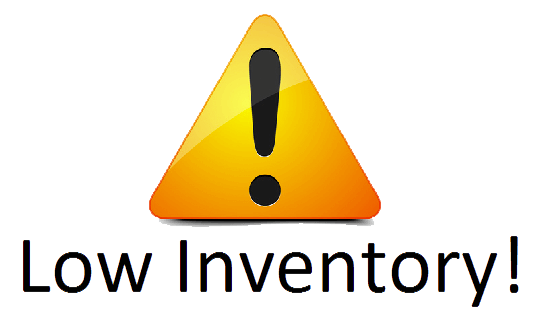Leveraging Reorder Points to Maintain Stock Levels

Best Practices: Leveraging Reorder Points to Maintain Stock Levels
It doesn’t matter if you’re a small start-up e-commerce business or a multi-warehouse giant, leveraging reorder points to maintain stock levels will have a positive effect on your day-to-day operations and help ensure that you capture every sale you can.

Even before my previous e-commerce business was mature enough to justify an inventory management software solution, I still relied on reorder points in spreadsheets to help me maintain stock levels. Believe me when I say every seller can benefit from using some sort of a reorder point to evaluate stock levels.
Your reorder point is the level of inventory you choose to indicate it’s time to order new stock. You can determine your reorder point in several different ways.
Sales Velocity
The most basic way to figure out a reorder point is to just look at your order history for any given product. If you sell 30 items in 30 days, and your ideal stock level is 30 days, then you should stock 30 of that product. This is referred to as your sales velocity. Figuring out how much inventory you move in a given time is a great way to decide how much to order on your next purchase.
It’s more of a business decision to determine what sort of back stock you want to keep. Some companies prefer shorter shelf life and more frequent replenishment orders, so 14 days would be more desirable. Other companies might order overseas or have a long replenishment cycle, so for those companies, a much larger back stock would be ideal. Here is the basic formula to calculate your sales velocity:

Reorder Points
Of course, sales velocity might not be right for everyone. Another common method of leveraging reorder points would be to set thresholds. Using sales velocity is just one way of figuring out what your threshold should be. Other common ways may be to set reorder points based on anticipated volume, purchase discount levels and any other number of ways that work best for your company.
If you choose to create your own reorder point formulas, refer to historical and current data, including your consumption rate, lead time and safety stock level for each product. For an even more effective model, factor in additional data like business growth, manufacturer changes and product quality variance.
No matter how you feel is the best way to calculate your reorder points, they can all be leveraged to the same effect.
Let’s say you never want to dip below 100 units on hand at any given time because it may take two months to receive more, and you don’t want to risk selling out. That would be your reorder point. When you get below 100, you order more. This may be the most basic way to set reorder points to help maintain your stock levels.
Maximum Reorder Points
Maximum reorder points, also called upper thresholds or desired stock levels, are particularly useful when using reorder points.
Setting the reorder point, or threshold at which you need to place an order, is only half of the battle. It is ideal to also set up a point to which you should reorder TO. For example, you may have an ideal stock level of 100 but don’t want to place an order for 1 if you dip to 99. You may, instead, want to reorder 75 once your stock level reaches 25. This would be a perfect example of reorder points being fully maximized. The reorder point is 25, but your reorder maximum would be 100.
Many software providers can do this for you, but it can also be done on a spreadsheet. You would just need to do a conditional statement:
Benefits of Setting Reorder Points
Setting a reorder point is one of the most effective ways to manage your inventory. Reorder point formulas help you to:
- Prevent stockouts: The most obvious advantage to calculating your reorder point is that it keeps you from regularly running out of stock.
- Provide better customer experience: With a lower chance of stockouts occurring, there’s a higher chance that customers will be satisfied with their orders. More satisfied customers mean more business for you.
- Reduce the risk of overstocking: The chance that you’ll order too much stock or restock too frequently is significantly lower since you have a solid idea of when you need more.
- Forecast more effectively: You can more accurately predict how long it will take you to run out of stock, and as long as you track how much you have, you can avoid accidental stockouts.
Remember that your reorder point can change based on external causes. Reevaluate your formula or sales velocity regularly to keep up with market trends and supply chain incidents.
The Importance of Safety Stock
Your safety stock is your emergency stock. If anything unexpected happens, whether that’s severe weather affecting your supply chain or a sudden spike in demand for a certain product, setting aside a specific number of units in addition to your ideal stock level can prevent most stockouts.
For example, let’s say you’re an online shoe retailer. Demand for one style of men’s loafers suddenly skyrockets, and these loafers are flying off warehouse shelves like never before. You quickly burn through your regular stock and have to wait a week for a new shipment to arrive. That’s where your safety stock comes in. It’ll allow you to keep selling the product for at least a portion of the time it will take you to replenish them without needing to resort to backorders.
Your daily stock consumption and average replenishment time are the two main factors you will need to calculate your ideal safety stock number. How much stock do you normally go through in a certain amount of time and how long does the restock process take? That number is how much safety stock you should keep.
For clarification, your safety stock number is different from your reorder point. Your safety stock is an addition to your regular stock. Your reorder point is the point at which you need to replenish your inventory.
Summary
In short, if you aren’t using reorder points to some degree, you should. Maintaining stock levels to cover future sales is extremely important for businesses to capitalize an items full sales potential.
Always remember: a healthy business has a healthy stock level.





